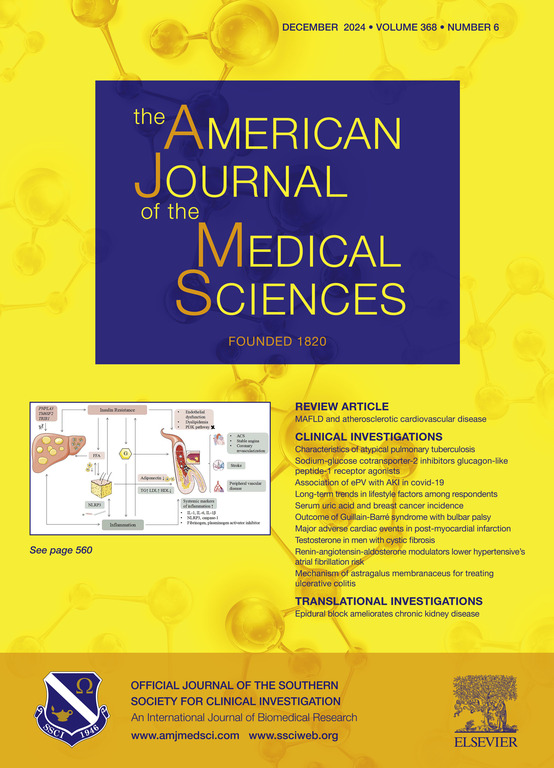Visceral adipose tissue area predicts major adverse kidney events in patients with acute necrotizing pancreatitis
IF 2.3
4区 医学
Q2 MEDICINE, GENERAL & INTERNAL
引用次数: 0
Abstract
Background
Given the previously reported harmful effects of abdominal fat burden on kidney function, we aim to investigate the relationship between major adverse kidney events within 30 days (MAKE30) and abdominal obesity in acute necrotizing pancreatitis (ANP) patients and explore the underlying risk factors.
Methods
A retrospective cohort study of all patients admitted within 72 h after the first episode of ANP to a tertiary center between June 2015 and June 2019 was conducted. Automatic image analysis software was used to calculate the area of subcutaneous adipose tissue (SAT), visceral adipose tissue (VAT) and skeletal muscle from computed tomography scans at the umbilical level. The potential risk factors of MAKE30 were analyzed by logistic regression.
Results
A total of 208 eligible ANP patients were enrolled, with an incidence of 23% for MAKE30. VAT area was more closely associated with the development of MAKE30, with an area under the ROC curve of 0.69 (cutoff value 200 cm2, 63.8% sensitivity and 66.7% specificity). Multivariate logistic regression analysis demonstrated that VAT area [OR 1.01 (1.01–1.02); p < 0.001] was an independent risk factor in predicting MAKE30. Patients with a VAT area > 200 cm2 had more requirements of renal replacement therapy (32% vs. 12%, P < 0.001), and a significantly higher incidence of other poor clinical outcomes (all p < 0.05).
Conclusion
Early assessment of the VAT area may help identify ANP patients at high risk of MAKE30, suggesting that it could be a potential indicator for adverse kidney events.
内脏脂肪组织面积可预测急性坏死性胰腺炎患者的主要肾脏不良事件。
背景:鉴于之前报道的腹部脂肪负担对肾功能的有害影响,我们旨在研究急性坏死性胰腺炎(ANP)患者30天内主要不良肾脏事件(MAKE30)与腹部肥胖之间的关系,并探索潜在的风险因素:对2015年6月至2019年6月期间某三级中心收治的首次ANP发作后72小时内的所有患者进行回顾性队列研究。使用自动图像分析软件从脐水平的计算机断层扫描中计算皮下脂肪组织(SAT)、内脏脂肪组织(VAT)和骨骼肌的面积。通过逻辑回归分析了MAKE30的潜在风险因素:结果:共有208名符合条件的ANP患者入选,MAKE30的发病率为23%。VAT面积与MAKE30的发生更密切相关,ROC曲线下面积为0.69(临界值为200平方厘米,敏感性为63.8%,特异性为66.7%)。多变量逻辑回归分析表明,VAT 面积[OR 1.01 (1.01-1.02); p < 0.001]是预测 MAKE30 的独立风险因素。VAT面积大于200平方厘米的患者需要接受肾脏替代治疗的比例更高(32% vs. 12%,P < 0.001),其他不良临床结局的发生率也明显更高(所有P < 0.05):结论:VAT面积的早期评估有助于识别MAKE30高风险的ANP患者,表明它可能是肾脏不良事件的潜在指标。
本文章由计算机程序翻译,如有差异,请以英文原文为准。
求助全文
约1分钟内获得全文
求助全文
来源期刊
CiteScore
4.40
自引率
0.00%
发文量
303
审稿时长
1.5 months
期刊介绍:
The American Journal of The Medical Sciences (AJMS), founded in 1820, is the 2nd oldest medical journal in the United States. The AJMS is the official journal of the Southern Society for Clinical Investigation (SSCI). The SSCI is dedicated to the advancement of medical research and the exchange of knowledge, information and ideas. Its members are committed to mentoring future generations of medical investigators and promoting careers in academic medicine. The AJMS publishes, on a monthly basis, peer-reviewed articles in the field of internal medicine and its subspecialties, which include:
Original clinical and basic science investigations
Review articles
Online Images in the Medical Sciences
Special Features Include:
Patient-Centered Focused Reviews
History of Medicine
The Science of Medical Education.

 求助内容:
求助内容: 应助结果提醒方式:
应助结果提醒方式:


